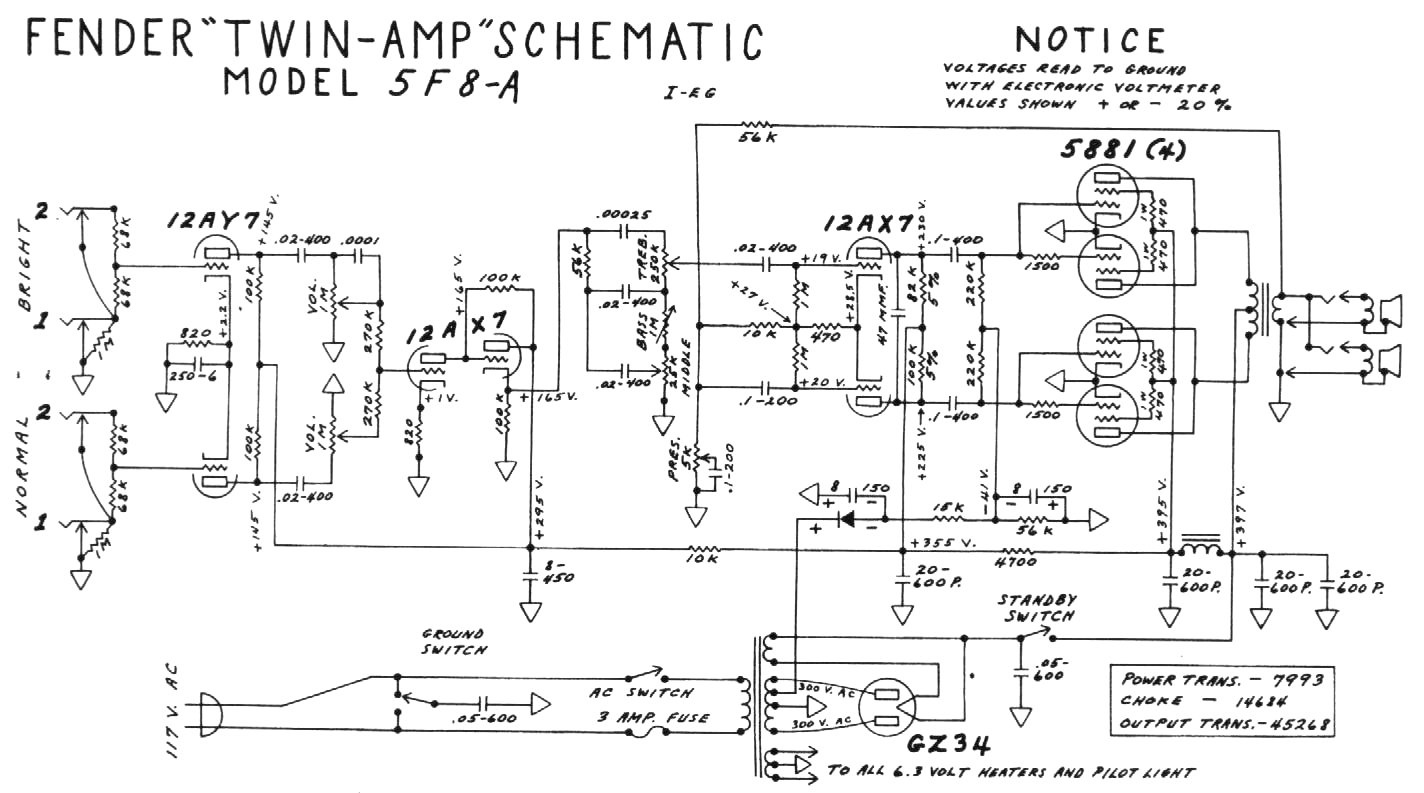I recently took possession of a 1959 Fender Twin, 5F8-A. It is mostly original. It has been in storage for years.
Before plugging it in I cleaned it and made a few checks.
I replaced two failed bias caps, and plugged amp into light bulb limiter to see what if it would work and what voltages are present .
No sound from amp so I started probing around.
As I have limited formal electronics training I am hoping I can post a few questions and those in the know can help me along.
Schematic and layout here for reference:


Here is what I have found so far in my Twin:
Red wires into rectifier, pins 4 & 6 measure 416V AC. Yellow wires going into rectifier tube 5 volts AC.
DC voltage coming out of rectifier tube, pin 8, that goes to stand-by switch reads 197.5 VDC. Measured at the connection on the standby switch. Found a bad standby switch. I don't have a spare, so I wired removed the switch temporarily and soldered wires directly together, eliminating switch.
Powered up amp. DC voltage on first two B+ caps climbs as high as a meagre 10V DC, then starts dropping and stabilizes at about 7 VDC. These are the original B+ caps still in there for now. Unsure if these are a problem yet at this point. I did measure and record original cap readings, read with a digital ESR meter. Here were my findings:
1959 Caps:
23.1uF 1.99 ohms
24.39uF 2.70 ohms
16.21uF 5.2 ohms
16.74uF 3.2 ohms
Next item in the power supply, I turned to the choke. I Took an resistance reading between the two black wires going in and out of it. I get 99 ohms. According to a Classictone replacement choke, the resistance is about 105 ohms. So I think my choke should be ok.
I am a unsure why the rectifier tube is putting out 197.5 VDC. I have a new Sovtek 5AR4 that I also put in there. Same results measured as vintage tube. Any ideas on the power supply?
Before I go ahead and replace the original power supply caps.? I agree they are old and should be changed anyway, before I do, I am wondering if they may be part of the symptoms I am seeing so far. Thanks.
Before plugging it in I cleaned it and made a few checks.
I replaced two failed bias caps, and plugged amp into light bulb limiter to see what if it would work and what voltages are present .
No sound from amp so I started probing around.
As I have limited formal electronics training I am hoping I can post a few questions and those in the know can help me along.
Schematic and layout here for reference:


Here is what I have found so far in my Twin:
Red wires into rectifier, pins 4 & 6 measure 416V AC. Yellow wires going into rectifier tube 5 volts AC.
DC voltage coming out of rectifier tube, pin 8, that goes to stand-by switch reads 197.5 VDC. Measured at the connection on the standby switch. Found a bad standby switch. I don't have a spare, so I wired removed the switch temporarily and soldered wires directly together, eliminating switch.
Powered up amp. DC voltage on first two B+ caps climbs as high as a meagre 10V DC, then starts dropping and stabilizes at about 7 VDC. These are the original B+ caps still in there for now. Unsure if these are a problem yet at this point. I did measure and record original cap readings, read with a digital ESR meter. Here were my findings:
1959 Caps:
23.1uF 1.99 ohms
24.39uF 2.70 ohms
16.21uF 5.2 ohms
16.74uF 3.2 ohms
Next item in the power supply, I turned to the choke. I Took an resistance reading between the two black wires going in and out of it. I get 99 ohms. According to a Classictone replacement choke, the resistance is about 105 ohms. So I think my choke should be ok.
I am a unsure why the rectifier tube is putting out 197.5 VDC. I have a new Sovtek 5AR4 that I also put in there. Same results measured as vintage tube. Any ideas on the power supply?
Before I go ahead and replace the original power supply caps.? I agree they are old and should be changed anyway, before I do, I am wondering if they may be part of the symptoms I am seeing so far. Thanks.

Comment